-
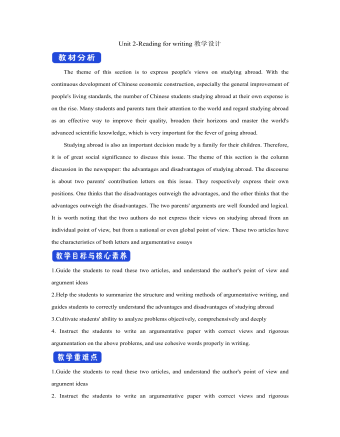
新人教版高中英语选修2Unit 2 Reading for writing教学设计
The theme of this section is to express people's views on studying abroad. With the continuous development of Chinese economic construction, especially the general improvement of people's living standards, the number of Chinese students studying abroad at their own expense is on the rise. Many students and parents turn their attention to the world and regard studying abroad as an effective way to improve their quality, broaden their horizons and master the world's advanced scientific knowledge, which is very important for the fever of going abroad. Studying abroad is also an important decision made by a family for their children. Therefore, it is of great social significance to discuss this issue. The theme of this section is the column discussion in the newspaper: the advantages and disadvantages of studying abroad. The discourse is about two parents' contribution letters on this issue. They respectively express their own positions. One thinks that the disadvantages outweigh the advantages, and the other thinks that the advantages outweigh the disadvantages. The two parents' arguments are well founded and logical. It is worth noting that the two authors do not express their views on studying abroad from an individual point of view, but from a national or even global point of view. These two articles have the characteristics of both letters and argumentative essays1.Guide the students to read these two articles, and understand the author's point of view and argument ideas2.Help the students to summarize the structure and writing methods of argumentative writing, and guides students to correctly understand the advantages and disadvantages of studying abroad3.Cultivate students' ability to analyze problems objectively, comprehensively and deeply
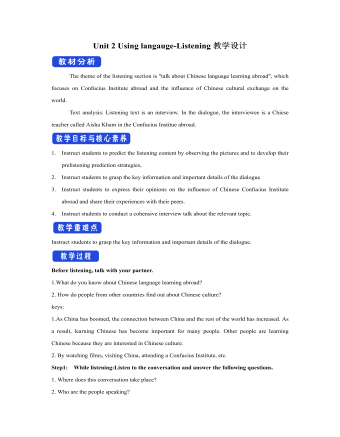
新人教版高中英语选修2Unit 2 Using langauge-Listening教学设计
? B: Absolutely! Getting involved with Chinese cultural activities there definitely helped a lot. I got to practice my Chinese on a daily basis, and I could learn how native Chinese speakers spoke.? A: What do you feel is your biggest achievement?? B: Learning Chinese characters! I have learnt about 1,500 so far. When I first started, I didn't think it was even going to be possible to learn so many, but now I find that I can read signs, menus, and even some easy newspaper articles.? A: What are you most keen on?? B: I've really become keen on learning more about the Chinese culture, in particular Chinese calligraphy. As I have learnt Chinese characters, I have developed a great appreciation for their meaning. I want to explore Chinese characters by learning how to write them in a more beautiful way. ? A: Finally, what do you want to say to anyone interested in learning Chinese?? I have really become keen on learning more about the Chinese culture, in particular Chinese Calligraphy. As I have learnt Chinese character, I have developed a great appreciation for their meaning. I want to explore Chinese characters by learning how to write them in a more beautiful way.? A: Finally, what do you want to say to anyone interested in learning Chinese?? B: I'd say, give it a shot! While some aspects may be difficult, it is quite rewarding and you will be happy that you tried.? A: Thanks for your time. ? B:You're welcome.
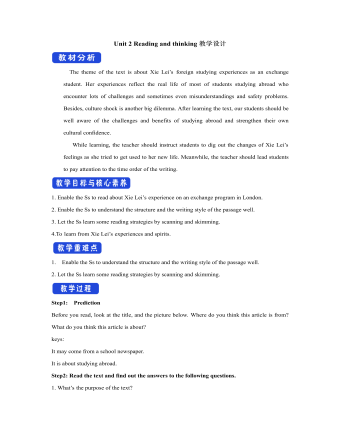
新人教版高中英语选修2Unit 2 Reading and thinking教学设计
Her tutor told her to acknowledge __________ other people had said if she cited their ideas, and advised her _______(read) lots of information in order to form __________wise opinion of her own.Now halfway __________ her exchange year, Xie Lei felt much more at home in the UK. She said __________ (engage) in British culture had helped and that she had been__________ (involve) in social activities. She also said while learning about business, she was acting as a cultural messenger __________(build) a bridge between the two countries. keys:Xie Lei, a 19yearold Chinese student, said goodbye to her family and friends in China and boarded (board) a plane for London six months ago in order to get a business qualification. She was ambitious(ambition) to set up a business after graduation. It was the first time that she had left (leave) home.At first, Xie Lei had to adapt to life in a different country. She chose to live with a host family, who can help with her adaptation (adapt) to the new culture. When she missed home, she felt comforted (comfort) to have a second family. Also Xie Lei had to satisfy academic requirements. Her tutor told her to acknowledge what other people had said if she cited their ideas, and advised her to read lots of information in order to form a wise opinion of her own.Now halfway through her exchange year, Xie Lei felt much more at home in the UK. She said engaging (engage) in British culture had helped and that she had been involved (involve) in social activities. She also said while learning about business, she was acting as a cultural messenger building a bridge between the two countries.
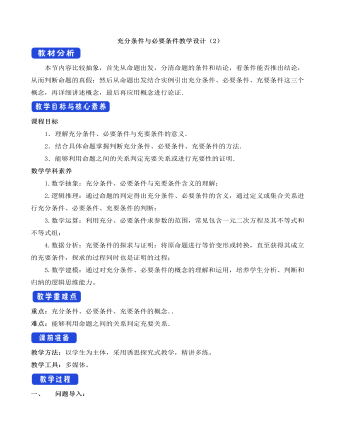
人教A版高中数学必修一充分条件与必要条件教学设计(2)
【例3】本例中“p是q的充分不必要条件”改为“p是q的必要不充分条件”,其他条件不变,试求m的取值范围.【答案】见解析【解析】由x2-8x-20≤0得-2≤x≤10,由x2-2x+1-m2≤0(m>0)得1-m≤x≤1+m(m>0)因为p是q的必要不充分条件,所以q?p,且p?/q.则{x|1-m≤x≤1+m,m>0}?{x|-2≤x≤10}所以m>01-m≥-21+m≤10,解得0<m≤3.即m的取值范围是(0,3].解题技巧:(利用充分、必要、充分必要条件的关系求参数范围)(1)化简p、q两命题,(2)根据p与q的关系(充分、必要、充要条件)转化为集合间的关系,(3)利用集合间的关系建立不等关系,(4)求解参数范围.跟踪训练三3.已知P={x|a-4<x<a+4},Q={x|1<x<3},“x∈P”是“x∈Q”的必要条件,求实数a的取值范围.【答案】见解析【解析】因为“x∈P”是x∈Q的必要条件,所以Q?P.所以a-4≤1a+4≥3解得-1≤a≤5即a的取值范围是[-1,5].五、课堂小结让学生总结本节课所学主要知识及解题技巧
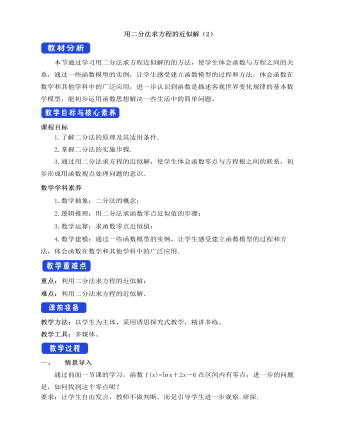
人教A版高中数学必修一用二分法求方程的近似解教学设计(2)
本节通过学习用二分法求方程近似解的的方法,使学生体会函数与方程之间的关系,通过一些函数模型的实例,让学生感受建立函数模型的过程和方法,体会函数在数学和其他学科中的广泛应用,进一步认识到函数是描述客观世界变化规律的基本数学模型,能初步运用函数思想解决一些生活中的简单问题。课程目标1.了解二分法的原理及其适用条件.2.掌握二分法的实施步骤.3.通过用二分法求方程的近似解,使学生体会函数零点与方程根之间的联系,初步形成用函数观点处理问题的意识.数学学科素养1.数学抽象:二分法的概念;2.逻辑推理:用二分法求函数零点近似值的步骤;3.数学运算:求函数零点近似值;4.数学建模:通过一些函数模型的实例,让学生感受建立函数模型的过程和方法,体会函数在数学和其他学科中的广泛应用.

两直线的交点坐标教学设计人教A版高中数学选择性必修第一册
1.直线2x+y+8=0和直线x+y-1=0的交点坐标是( )A.(-9,-10) B.(-9,10) C.(9,10) D.(9,-10)解析:解方程组{■(2x+y+8=0"," @x+y"-" 1=0"," )┤得{■(x="-" 9"," @y=10"," )┤即交点坐标是(-9,10).答案:B 2.直线2x+3y-k=0和直线x-ky+12=0的交点在x轴上,则k的值为( )A.-24 B.24 C.6 D.± 6解析:∵直线2x+3y-k=0和直线x-ky+12=0的交点在x轴上,可设交点坐标为(a,0),∴{■(2a"-" k=0"," @a+12=0"," )┤解得{■(a="-" 12"," @k="-" 24"," )┤故选A.答案:A 3.已知直线l1:ax+y-6=0与l2:x+(a-2)y+a-1=0相交于点P,若l1⊥l2,则点P的坐标为 . 解析:∵直线l1:ax+y-6=0与l2:x+(a-2)y+a-1=0相交于点P,且l1⊥l2,∴a×1+1×(a-2)=0,解得a=1,联立方程{■(x+y"-" 6=0"," @x"-" y=0"," )┤易得x=3,y=3,∴点P的坐标为(3,3).答案:(3,3) 4.求证:不论m为何值,直线(m-1)x+(2m-1)y=m-5都通过一定点. 证明:将原方程按m的降幂排列,整理得(x+2y-1)m-(x+y-5)=0,此式对于m的任意实数值都成立,根据恒等式的要求,m的一次项系数与常数项均等于零,故有{■(x+2y"-" 1=0"," @x+y"-" 5=0"," )┤解得{■(x=9"," @y="-" 4"." )┤

圆的标准方程教学设计人教A版高中数学选择性必修第一册
(1)几何法它是利用图形的几何性质,如圆的性质等,直接求出圆的圆心和半径,代入圆的标准方程,从而得到圆的标准方程.(2)待定系数法由三个独立条件得到三个方程,解方程组以得到圆的标准方程中三个参数,从而确定圆的标准方程.它是求圆的方程最常用的方法,一般步骤是:①设——设所求圆的方程为(x-a)2+(y-b)2=r2;②列——由已知条件,建立关于a,b,r的方程组;③解——解方程组,求出a,b,r;④代——将a,b,r代入所设方程,得所求圆的方程.跟踪训练1.已知△ABC的三个顶点坐标分别为A(0,5),B(1,-2),C(-3,-4),求该三角形的外接圆的方程.[解] 法一:设所求圆的标准方程为(x-a)2+(y-b)2=r2.因为A(0,5),B(1,-2),C(-3,-4)都在圆上,所以它们的坐标都满足圆的标准方程,于是有?0-a?2+?5-b?2=r2,?1-a?2+?-2-b?2=r2,?-3-a?2+?-4-b?2=r2.解得a=-3,b=1,r=5.故所求圆的标准方程是(x+3)2+(y-1)2=25.
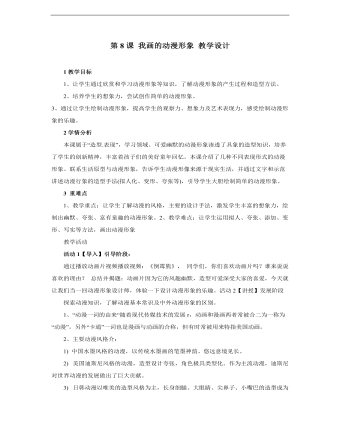
小学美术人教版四年级下册《第8课我画的动漫形象3》教学设计说课稿
2学情分析本课属于“造型.表现”,学习领域。可爱幽默的动漫形象渗透了具象的造型知识,培养了学生的创新精神,丰富着孩子们的美好童年回忆。本课介绍了几种不同表现形式的动漫形象。联系生活原型与动漫形象,告诉学生动漫形像来源于现实生活,并通过文字和示范讲述动漫行象的造型手法(拟人化、变形、夸张等),引导学生大胆绘制简单的动漫形象。3 重难点1、教学重点:让学生了解动漫的风格,主要的设计手法,激发学生丰富的想象力,绘制出幽默、夸张、富有童趣的动漫形象。2、教学难点:让学生运用拟人、夸张、添加、变形、写实等方法,画出动漫形象
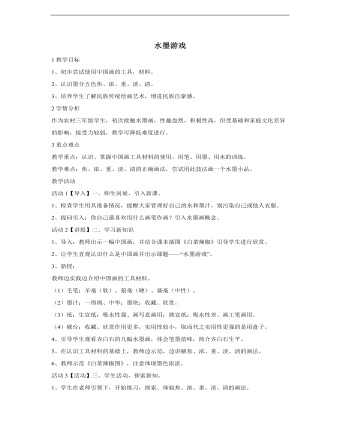
小学美术人教版三年级下册《第1课水墨游戏》教学设计说课稿
3重点难点教学重点:认识、掌握中国画工具材料的使用。用笔、用墨、用水的训练。教学难点:焦、浓、重、淡、清的正确画法,尝试用此技法画一个水墨小品。教学活动活动1【导入】一、师生问候,引入新课。1、检查学生用具准备情况,提醒大家管理好自己的水和墨汁,别污染自己或他人衣服。2、提问引入:你自己最喜欢用什么画笔作画?引入水墨画概念。
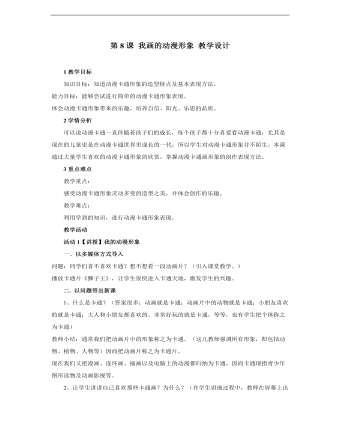
小学美术人教版四年级下册《第8课我画的动漫形象4》教学设计说课稿
2学情分析可以说动漫卡通一直伴随着孩子们的成长,每个孩子都十分喜爱看动漫卡通,尤其是现在的儿童更是在动漫卡通世界里成长的一代,所以学生对动漫卡通形象并不陌生。本课通过大量学生喜欢的动漫卡通形象的欣赏,掌握动漫卡通画形象的创作表现方法。3重点难点教学重点:感受动漫卡通形象灵动多变的造型之美,并体会创作的乐趣。教学难点:利用学到的知识,进行动漫卡通形象表现。

人教版高中历史必修2开辟新航路说课稿3篇
一、说教材《开辟新航路》是高中《历史·必修二》第5课的内容。从三个方面向学生介绍了欧洲人开辟新航路的历史:即新航路开辟的原因和条件、新航路开辟经过以及影响。前4课内容介绍了古代中国经济的基本结构与特点,从第5课开始学习资本主义世界市场的形成和发展。本课内容相当重要,上承古代中国,下启近代世界。新航路的开辟,打破了世界相对隔绝的状态,世界真正开始融合为一个整体。从此,以西欧为中心的世界市场的雏形开始出现。随后的殖民扩张,世界市场拓展;第一次工业革命,世界市场基本形成;第二次工业革命,世界市场发展。二、说目标1、课程标准概述迪亚士、哥伦布开辟新航路的史实,认识地理大发现对世界市场形成的意义。2、三维目标①知识与能力:掌握新航路开辟的原因、经过、影响。②过程与方法:引导学生分析原因及影响,培养学生分析和归纳问题的能力。③情感态度与价值观:A、通过对新航路开辟过程的学习,使学生感受和学习探险家们勇于进取的开拓精神。B、通过学习新航路开辟的影响,使学生认识新航路开辟促进了人类社会的整体发展。
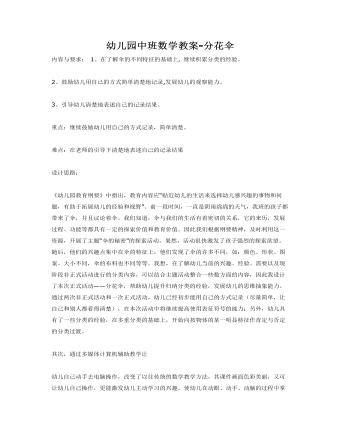
幼儿园中班数学教案-分花伞
2、鼓励幼儿用自己的方式简单清楚地记录,发展幼儿的观察能力。3、引导幼儿清楚地表述自己的记录结果。重点:继续鼓励幼儿用自己的方式记录,简单清楚。难点:在老师的引导下清楚地表述自己的记录结果 设计思路:《幼儿园教育纲要》中指出,教育内容应“贴近幼儿的生活来选择幼儿感兴趣的事物和问题,有助于拓展幼儿的经验和视野”。前一段时间,一直是阴雨绵绵的天气,我班的孩子都带来了伞,并且议论着伞。我们知道,伞与我们的生活有着密切的关系,它的来历,发展过程、功能等都具有一定的探索价值和教育价值。因此我们根据纲要精神,及时利用这一资源,开展了主题“伞的秘密”的探索活动。果然,活动很快激发了孩子强烈的探索欲望。随后,他们的兴趣点集中在伞的特征上,他们发现了伞的许多不同,如:颜色、形状、图案、大小不同,伞的布料也不同等等。我想,在了解幼儿当前的兴趣、经验、需要以及现阶段非正式活动进行的分类内容,可以结合主题活动整合一些数方面的内容,因此我设计了本次正式活动——分花伞,帮助幼儿提升归纳分类的经验,发展幼儿的思维抽象能力。通过两次非正式活动和一次正式活动,幼儿已经初步能用自己的方式记录(尽量简单,让自己和别人都看得清楚),在本次活动中将继续提高使用表征符号的能力;另外,幼儿具有了一些分类的经验,在多重分类的基础上,开始向按物体的某一明显特征作肯定与否定的分类过渡。
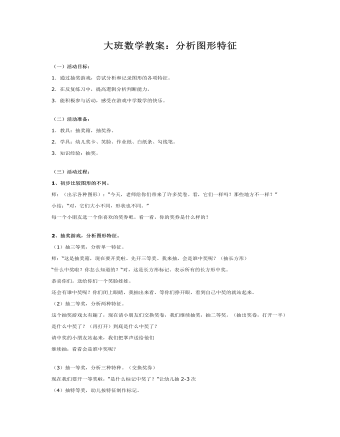
大班数学教案:分析图形特征
(二)活动准备: 1.教具:抽奖箱,抽奖券。 2.学具:幼儿奖卡、笑脸、作业纸、白纸条、勾线笔。 3.知识经验:抽奖。 (三)活动过程: 1、初步比较图形的不同。 师:(出示各种图形):“今天,老师给你们带来了许多奖卷。看,它们一样吗?那些地方不一样?” 小结:“对,它们大小不同,形状也不同。” 每一个小朋友选一个你喜欢的奖券吧。看一看,你的奖券是什么样的? 2、抽奖游戏,分析图形特征。 (1)抽三等奖,分析单一特征。 师:“这是抽奖箱,现在要开奖啦。先开三等奖。我来抽,会是谁中奖呢?(抽长方形) “什么中奖啦?你怎么知道的?“对,这是长方形标记。表示所有的长方形中奖。 恭喜你们。送给你们一个笑脸娃娃。 还会有谁中奖呢?你们闭上眼睛,我抽出来看。等你们挣开眼,看到自己中奖的就站起来。
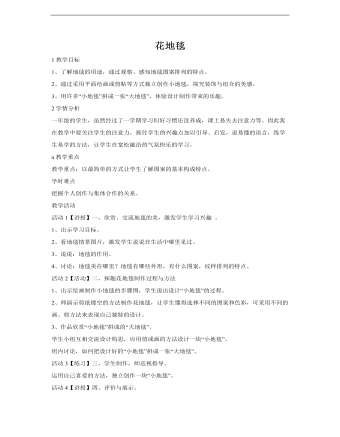
小学美术人教版一年级下册《第3课花地毯》教学设计
2学情分析一年级的学生,虽然经过了一学期学习但好习惯还没养成,课上易失去注意力等。因此我在教学中要关注学生的注意力,抓住学生的兴趣点加以引导、启发,说易懂的语言,练学生易学的方法,让学生在宽松融洽的气氛快乐的学习。a教学重点教学重点:以最简单的方式让学生了解图案的基本构成特点。学时难点把握个人创作与集体合作的关系。
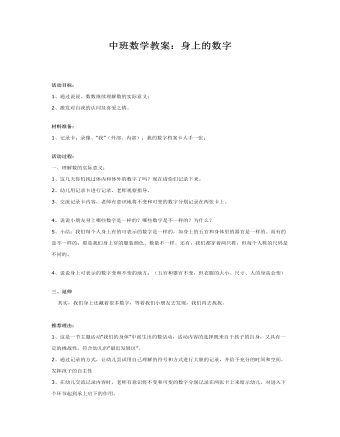
中班数学教案:身上的数字
2、激发对自我的认同及喜爱之情。材料准备:1、记录卡;录像、“我”(外部、内部);我的数字档案卡人手一张;活动过程: 一、理解数的实际意义:1、这几天你们找过体内和体外的数字了吗?现在请你们记录下来。2、幼儿用记录卡进行记录,老师观察指导。3、交流记录卡内容,老师有意识地将不变和可变的数字分别记录在两张卡上。4、说说小朋友身上哪些数字是一样的?哪些数字是不一样的?为什么?
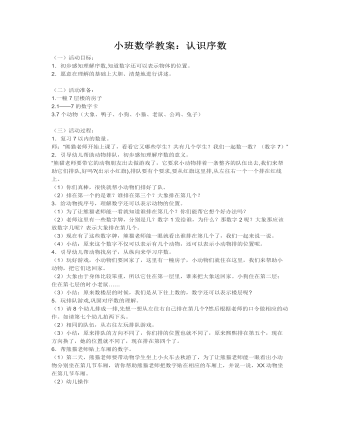
小班数学教案:认识序数
(二)活动准备: 1.一幢7层楼的房子 2.1——7的数字卡 3.7个动物(大象、鸭子、小狗、小猫、老鼠、公鸡、兔子) (三)活动过程: 1.复习7以内的数量。 师:“熊猫老师开始上课了,看看它又哪些学生?共有几个学生?我们一起数一数?(数字7)” 2.引导幼儿帮助动物排队,初步感知理解序数的意义。 “熊猫老师要带它的动物朋友出去做游戏了,它要求小动物排着一条整齐的队伍出去,我们来帮助它们排队,好吗?(出示小红旗),排队要有个要求,要从红旗这里排,从左往右一个一个排在红线上。 (1)你们真棒,很快就帮小动物们排好了队。 (2)排在第一个的是谁?谁排在第三个?大象排在第几个?
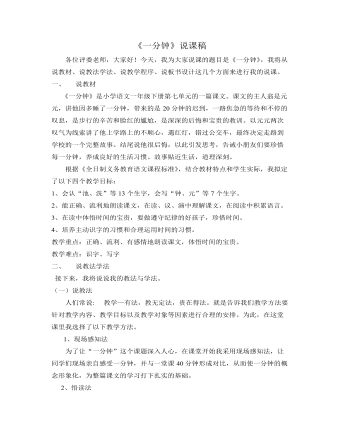
部编人教版一年级下册《一分钟》说课稿
《一分钟》是小学语文一年级下册第七单元的一篇课文。课文的主人翁是元元,讲他因多睡了一分钟,带来的是20分钟的迟到,一路焦急的等待和不停的叹息,是步行的辛苦和脸红的尴尬,是深深的后悔和宝贵的教训。以元元两次叹气为线索讲了他上学路上的不顺心,遇红灯,错过公交车,最终决定走路到学校的一个完整故事。结尾说他很后悔,以此引发思考,告诫小朋友们要珍惜每一分钟,养成良好的生活习惯。故事贴近生活,道理深刻。根据《全日制义务教育语文课程标准》,结合教材特点和学生实际,我拟定了以下四个教学目标:1、 会认“池、洗”等13个生字,会写“钟、元”等7个生字。2、 能正确、流利地朗读课文,在读、议、演中理解课文,在阅读中积累语言。3、 在读中体悟时间的宝贵,要做遵守纪律的好孩子,珍惜时间。4、 培养主动识字的习惯和合理运用时间的习惯。教学重点:正确、流利、有感情地朗读课文,体悟时间的宝贵。教学难点:识字、写字
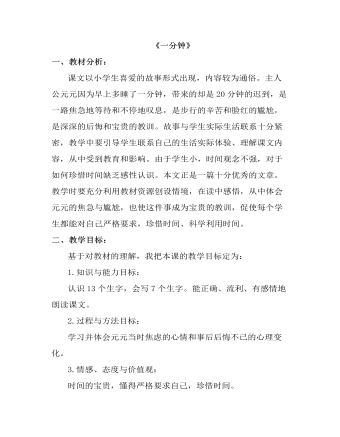
部编人教版一年级下册《一分钟》(说课稿)
一、教材分析:课文以小学生喜爱的故事形式出现,内容较为通俗。主人公元元因为早上多睡了一分钟,带来的却是20分钟的迟到,是一路焦急地等待和不停地叹息,是步行的辛苦和脸红的尴尬,是深深的后悔和宝贵的教训。故事与学生实际生活联系十分紧密,教学中要引导学生联系自己的生活实际体验、理解课文内容,从中受到教育和影响。由于学生小,时间观念不强,对于如何珍惜时间缺乏感性认识。本文正是一篇十分优秀的文章。教学时要充分利用教材资源创设情境,在读中感悟,从中体会元元的焦急与尴尬,也使这件事成为宝贵的教训,促使每个学生都能对自己严格要求,珍惜时间、科学利用时间。
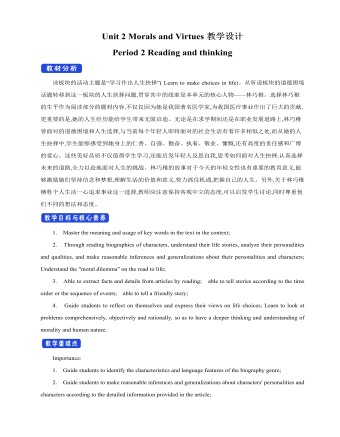
新人教版高中英语必修3Unit 2 Morals and Virtues教学设计二
Activity 41. Students complete the task of activity 4, then teachers and students check the answers. 2. The teacher organized the students to work together and asked them to use the tables and mind maps sorted out before to retold the important choices in Lin Qiaozhi's life and their resultsStep 5 Language points1. The teacher asks the students to read the text carefully, find out the core words and long and difficult sentences in the text and draw lines, understand the use of vocabulary, and analyze the structure of long and difficult sentences. 2. The teacher explains and summarizes the usage of core vocabulary and asks the students to take notes. 3. The teacher analyzes and explains the long and difficult sentences that the students don't understand, so that the students can understand them better. Step 6 Homework1. Read the text again, in-depth understanding of the text; 2. Master the use of core vocabulary and understand the long and difficult sentences. 3. Complete relevant exercises in the guide plan. 1、通过本节内容学习,学生是否理解和掌握阅读文本中的新词汇的意义与用法;2、通过本节内容学习,学生能否结合文本特点总结林巧稚的人生原则和人格品质特征;3、通过本节内容学习,学生能否针对人生抉择发表自己的看法;能否全面地、客观地、理性地看待问题,进而对道德和人性有更加深入的思考和理解。
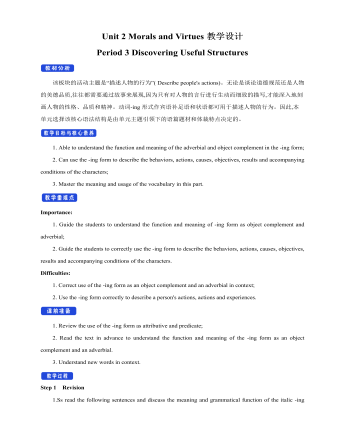
新人教版高中英语必修3Unit 2 Morals and Virtues教学设计三
The joke set her crying.这个玩笑使她哭起来。Step 5 ReadingActivity 31. Students read the small text in activity 3. The teacher provides several small questions to check whether students understand the content of the text and the ideographic function of the -ing form in the text.*Where are those people?*Why did Dr Bethune come to China?*How did he help the Chinese people during the war?*What did Chairman Mao Zedong say about him?2. Ss try to rewrite some sentences using the -ing form. Then check the answers. When checking the answers, the teacher can ask different students to read the rewritten sentences and give comments.Answers:1. he became very interested in medicine, deciding to become a doctor.2. …after hearing that many people were dying in the war.3. Helping to organise hospitals, he taught doctors and nurses, and showed people how to give first aid./ He helped to organise hospitals, teaching doctors and nurses, and showing people how to give first aid.4. …praising Dr Bethune as a hero to be remembered in China.Step 6 PracticeActivity 4Students complete grammar activities 2 and 3 on page 69 of the workbook.Step 6 Homework1. Understand and master the functions and usage of the -ing form;2. Finish the other exercises in Using structures.1、通过本节内容学习,学生是否理解和掌握动词-ing形式作宾语补足语语和状语语的功能和意义;2、通过本节内容学习,学生能否正确使用动词-ing形式描述人物的行为、动作及其经历;3、通过本节内容学习,学生能否独立完成练习册和导学案中的相关练习。

